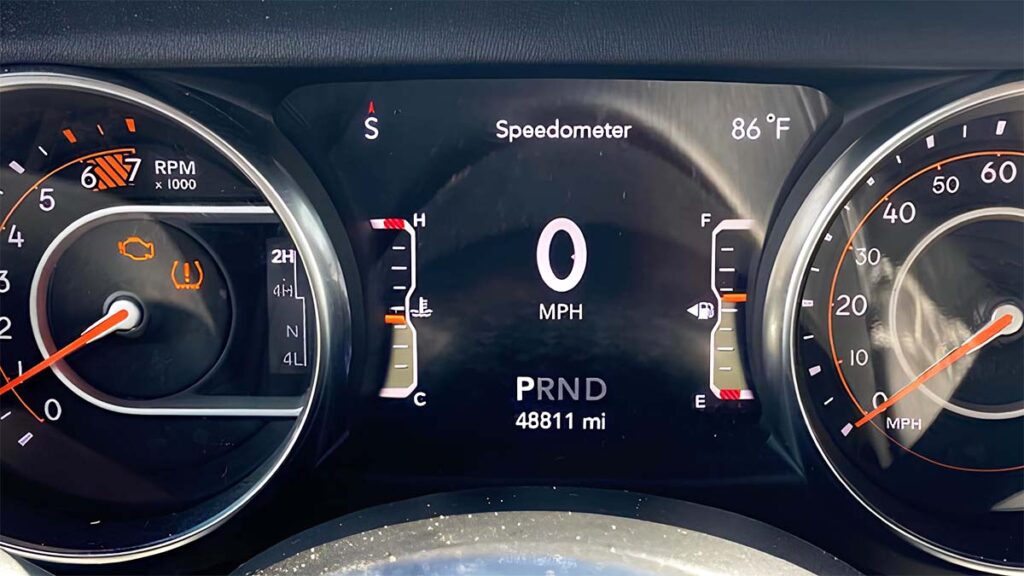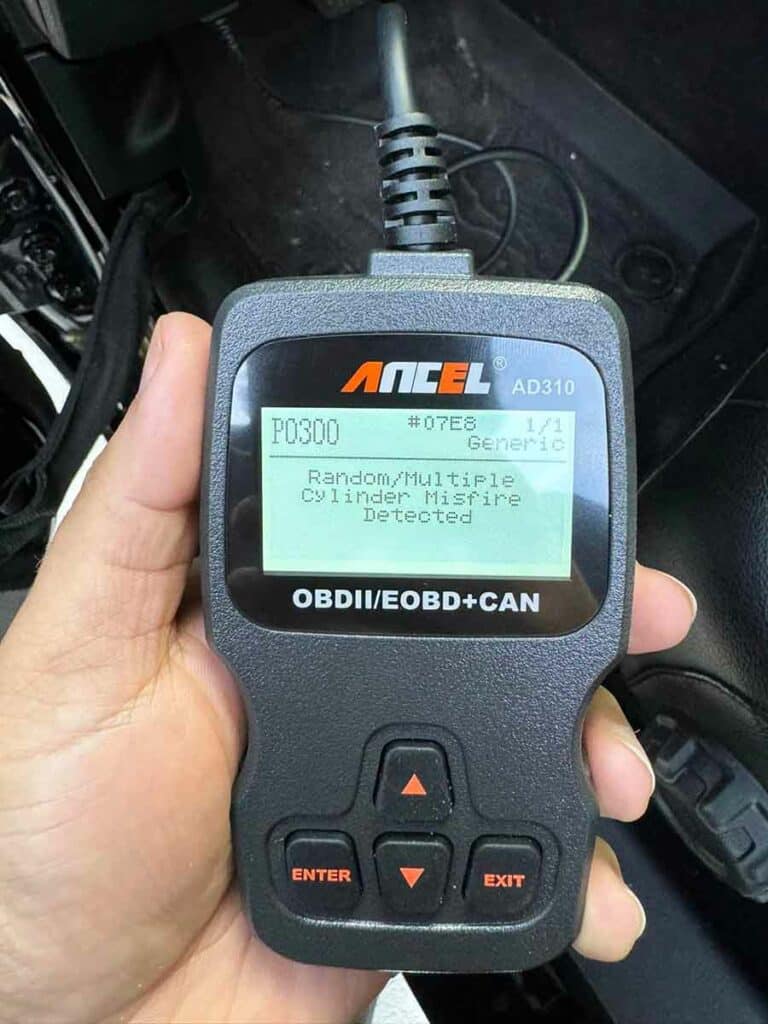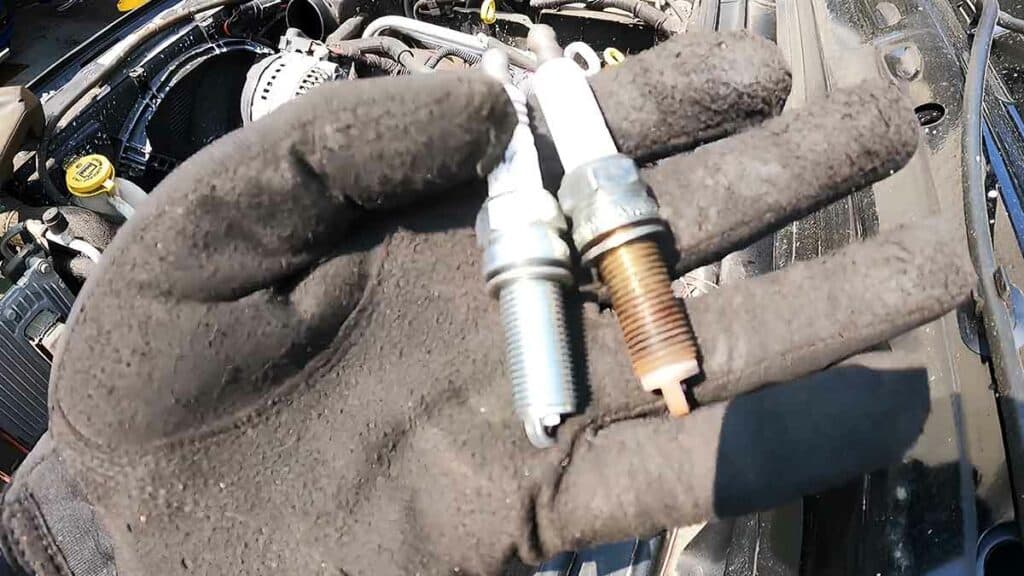Why Is My Jeep Check Engine Light Flashing? (13 Major Causes And Their Fixes)
If you’re cruising in your Jeep and suddenly the check engine light starts flashing, it can be nerve-wracking. You may jump to the worst-case scenario, thinking your engine’s about to give up.
If the check engine light flashes precisely 10 times before starting the engine, it’s not an issue. But if the check engine light flashes when you drive, then it’s a serious problem.
In that case, the flashing check engine light indicates that your Jeep engine is experiencing issues, which can be caused by problems such as worn-out spark plugs, faulty fuel injectors, vacuum leaks, or even a bad battery. Components like the ignition coil, crankshaft sensors, camshaft sensors, and leaking valves are also potential culprits that may need attention.

In this article, I’ll break down the common reasons why your Jeep’s check engine light is flashing and help you determine if it’s a serious problem or just a minor hiccup.
Table of Contents
What Does It Mean When Jeep’s Check Engine Light Flashes?
The check engine light in your Jeep can flash while you drive and when you turn on your Jeep. Each time, it means something different.
When Jeeps check engine light flashes, if you start the car but not the engine, and if it flashes precisely 10 times, then it’s a good thing. It means the system has checked everything by completing a “Drive Cycle” and is now ready to drive. It can be tested for emissions now.
If the check engine light keeps blinking, it means the system is not ready. It has not completed the “Drive Cycle” and needs to be completed.
When your Jeep’s check engine light starts flashing while you drive, it’s like your Jeep’s way of saying, “Hey, something needs attention!”
The check engine light is part of your Jeep’s intelligent system that keeps an eye on things.
It can appear as “Check Engine,” a symbol of an engine, or a mix of both.
Since the ’80s, on-board computers have been the brain behind your Jeep’s performance, doing essential tasks like controlling engine speed, shifting gears in automatic transmissions, setting ignition timing, and keeping things stable on the road.
So, when the check engine light blinks while you drive, it’s like your Jeep’s computer waving a flag to get your attention.
It may be a minor hiccup, or it may indicate a more serious problem.
So, when that light flashes, it’s your Jeep’s way of saying, “Let’s get this checked out.” You need to stop driving and check out your Jeep as soon as possible.
What Causes the Jeep Check Engine Light Flashing? How Do You Fix It?
If your Jeep’s check engine light is flashing, it’s like a red flag waving – a serious issue is happening.
An OBD-II (On-Board Diagnostics) scanner is essential for analyzing and diagnosing issues with your Jeep when the check engine light blinks.
OBD-II scanners provide detailed information about the detected issues.
Using an OBD-II scanner is a cost-effective way to gather diagnostic information.
It lets you quickly identify issues without requiring extensive manual inspection or trial-and-error methods.
If your Jeep’s check engine light blinks and you hook up your OBD-II scanner, you’ll get code P0300.

Code P0300 indicates a random or multiple misfires in the engine.
Specifically, one or more cylinders are not contributing as expected, resulting in an overall imbalance in engine performance.
Possible Causes of a Random/Multiple Misfire (P0300)
Different types of issues can cause engine misfires. They are:
- Ignition System Issues: Problems with spark plugs, ignition coils, spark plug wires, or the distributor.
- Fuel System Issues: Issues with fuel injectors and fuel pressure.
- Air Intake/Exhaust Issues: Vacuum leaks, air intake problems, or exhaust system restrictions.
- Engine Mechanical Problems: Issues with the compression in one or more cylinders, such as a leaking head gasket or damaged valves.
- Sensor Issues: Faulty sensors, such as the crankshaft position sensor or camshaft position sensor.
- Timing Issues: Incorrect ignition timing or problems with the timing belt/chain.
It’s important to note that while P0300 indicates a random misfire, additional codes (P0301, P0302, P0303, etc.) may accompany it to specify which cylinders are experiencing the misfire. For example:
| OBD-II Code | Description |
| P0301 | Cylinder 1 Misfire Detected |
| P0302 | Cylinder 2 Misfire Detected |
| P0303 | Cylinder 3 Misfire Detected |
| P0304 | Cylinder 4 Misfire Detected |
| P0305 | Cylinder 5 Misfire Detected |
| P0306 | Cylinder 6 Misfire Detected |
If specific cylinder codes are present, they can help narrow the investigation to identify the root cause of the misfire in those particular cylinders.
Now, what is a misfire? An internal combustion engine will misfire if one or more cylinders are unable to ignite the air-fuel mixture correctly.
Instead of a smooth and controlled combustion process, the affected cylinder(s) fuel may not burn or burn inefficiently.
Persistent misfires can lead to severe engine damage over time. Incomplete combustion results in unburned fuel entering the exhaust system, causing excessive heat and potentially damaging the catalytic converter.
What Are the Symptoms of an Engine Misfire?
You can sense an engine misfire from some outside symptoms as well.
Reduced Fuel Efficiency
Misfires can significantly reduce fuel efficiency as unburned fuel is wasted. This can increase fuel costs.
Emission Increase
Incomplete combustion leads to higher emissions of harmful pollutants. This may result in a car failing emission tests and polluting the environment.
Loss of Power and Performance
Misfires can cause a noticeable reduction in engine power and overall vehicle performance. You’ll get sluggish acceleration, and the Jeep won’t respond as you expect.
Engine Vibrations and Rough Idling
Misfiring cylinders can cause excessive vibration in the engine, resulting in a rough idle.
This indicates potential damage to engine components.
Causes of Engine Misfires With Their Potential Fixes
Detecting and addressing engine misfires promptly is crucial. The reasons behind engine misfires and check engine light blinking are listed below:
1. Faulty Spark Plug
A faulty spark plug can be behind a Jeep’s check engine light flashing.
Spark plugs ignite the air-fuel mixture in the combustion chamber, and when they are not functioning correctly, it can lead to misfires.
Remove the spark plug and inspect its condition. Look for signs of fouling, such as deposits or carbon buildup. Worn or damaged electrodes can also indicate a problem.

If a spark plug is covered in oil, it can’t fire correctly.
Check the spark plug gap using a gapping tool. Incorrect gap size can affect the spark plug’s ability to generate a spark.
If you identify a bad spark plug, it’s essential to replace it. Use the manufacturer-recommended spark plugs for your Jeep model. Use fuel from reputable sources.
2. Damaged Spark Plug Wires
Issues with spark plug wires can contribute to a Jeep’s check engine light flashing.
Spark plug wires, also known as ignition or spark plug cables, play a crucial role in transmitting the electrical energy from the ignition coil to the spark plugs, ensuring proper ignition in the engine cylinders. Here’s what you should do:
Inspect the spark plug wires for visible signs of damage, such as cracks, burns, or wear. Look for any exposed wires.
Use a multimeter to check the resistance. Excessive resistance can hinder the flow of electrical energy.
Securely connect the spark plug wires. Loose connections can lead to weak or intermittent sparks.
If you identify damaged or worn spark plug wires, replace them. Use high-quality OEM or recommended replacement wires.
Ensure that the spark plug wires are routed correctly and are not in contact with hot engine components, which can lead to damage.
3. Vacuum Leak on the Motor
A vacuum leak on the motor can be a potential cause of a Jeep’s check engine light flashing.
A vacuum leak occurs when there is an unintended opening or gap in the vacuum system, allowing unmetered air to enter the engine.
This disrupts the air-fuel mixture, leading to issues like misfires and triggering the check engine light. Here’s an explanation of vacuum leaks and what you should do:
A flashing check engine light or a steady glow may indicate a vacuum leak, especially if accompanied by symptoms like rough idling.
The engine may exhibit irregular or rough idling when a vacuum leak occurs.
Reduced engine performance, hesitation, or a lack of power during acceleration can be observed.
When the vehicle is running, a hissing sound from the engine compartment can be a sign of a vacuum leak.
Check vacuum hoses and lines for cracks, splits, or disconnected sections. Check the intake manifold gasket for damage.
Look for any hissing noises while the engine is running, as these may point to the vacuum leak’s location.
Inspect components such as the brake booster, PCV valve, and vacuum-controlled accessories for potential issues.
Replace any damaged vacuum hoses, gaskets, or components contributing to the leak.
4. Low Fuel Pressure
Low fuel pressure can contribute to a flashing check engine light in a Jeep, and addressing this issue often involves examining the fuel system, including the fuel filter and fuel pump.
Inadequate fuel pressure can lead to incomplete combustion in the engine cylinders. It can cause misfires.
Low fuel pressure can cause a decrease in engine power, rough idling, and difficulty accelerating.
Low fuel pressure can sometimes lead to a lean fuel mixture, where the air-fuel ratio is skewed. This can affect combustion efficiency.
In time, the fuel filter can become blocked by dirt and contaminants present in the fuel. The fuel supply to the engine is impeded by a clogged filter.
Clean fuel is delivered to the engine thanks to the fuel filter. Changing the fuel filter regularly helps maintain optimal fuel quality and prevents debris from entering the fuel injectors.
A clogged fuel filter can lead to increased stress on fuel injectors, potentially causing damage and affecting their performance.
The fuel pump maintains adequate fuel pressure in the fuel system. A weak or failing pump will cause low fuel pressure.
If changing the fuel filter does not resolve the low fuel pressure issue, the fuel pump may be the culprit. Replacing a failing fuel pump can restore proper fuel pressure.
Changing the fuel filter is a relatively simpler and cost-effective step. It’s a good starting point to address potential fuel delivery issues.
After changing the fuel filter, assess the fuel pressure. If fuel pressure is consistently low, replacing the fuel pump becomes necessary. A failing fuel pump can contribute to persistent low fuel pressure issues.
5. Faulty Fuel Injector
A faulty fuel injector can contribute to a Jeep’s check engine light flashing, indicating a serious issue.
Misfires can occur when a malfunctioning fuel injector injects the wrong amount of fuel into the combustion chamber.
An improperly functioning fuel injector can disrupt the optimal air-fuel mixture, resulting in decreased fuel efficiency.
Malfunctioning fuel injectors can affect combustion.

Use an OBD-II scanner. A specific code related to the fuel injector may appear.
Check for visual signs of a faulty fuel injector, such as leaks, clogs, or damage. Look for wet areas around the injector or the smell of fuel.
Ensure that the electrical connectors and wires associated with the fuel injector are secure and in good condition.
If you suspect fuel injector issues, consider using a fuel system cleaner or having a professional injector cleaning service performed.
This can sometimes resolve minor clogs or deposits affecting injector performance.
If the fuel injector is found faulty, replacement is often necessary.
6. Blown Head Gasket
A blown head gasket can contribute to a Jeep’s check engine light flashing. In order to stop coolant and oil from mixing in the combustion chamber, the head gasket seals the cylinder head to the engine block.
When a head gasket fails, it can lead to various problems, including engine misfires, overheating, and the activation of the check engine light.
Coolant leakage into the combustion chamber can occur because of a cracked head gasket. This can cause a Jeep’s CEL to flash.
The compromised head gasket may mix coolant and oil, causing the engine to overheat. Overheating can lead to severe engine damage.
Coolant entering the combustion chamber can produce white smoke from the exhaust, indicating a head gasket issue.
Oil and coolant mixing due to a damaged head gasket can contaminate the engine oil, reducing its lubricating properties.
A compression test is a diagnostic procedure to assess the integrity of the head gasket and overall engine health. In some cylinders, lower compression levels can be a sign of a head gasket failure.
Look for indications of oil and coolant leaks near the engine. A noticeable coolant or oil leak may suggest a head gasket issue.
A compression test can help verify head gasket problems if you think you may have a blown gasket.
If a blown head gasket is confirmed, it’s essential to replace it promptly. This is a complex repair that typically requires the expertise of a qualified mechanic.
7. Faulty Ignition Coil
An ignition coil can be a potential cause behind a Jeep’s check engine light flashing.
The low-voltage electrical power from the battery is transformed into the high-voltage power required to ignite the spark plugs by the ignition coil.
If the ignition coil is faulty, misfires can happen.
Codes related to ignition coil issues (e.g., P0300 for random misfires or specific cylinder misfire codes) can help identify the problem.
See if the ignition coil has any cracks or physical wear. Measure the resistance of the ignition coil.
Refer to the service manual for your car. There shouldn’t be any significant deviation.
Replace the ignition coil with a new, high-quality coil if it is determined to be malfunctioning. Ensure you use the recommended type of ignition coil.
In cases of ignition coil issues, it’s advisable to replace the spark plugs as well. Misfires can lead to fouling and wear on the spark plugs.
8. Leaking Valve Cover
A leaking valve cover can contribute to a Jeep’s check engine light flashing, and addressing this issue is vital for the engine’s proper functioning.
The engine’s cylinder head’s top is sealed off by the valve cover. If it develops a leak, engine oil can escape and potentially reach other engine components.
Oil leaking from the valve cover can interfere with the proper operation of the spark plugs, leading to misfires and triggering the check engine light.
Oil leakage can impact the engine’s overall performance, causing it to run less efficiently and leading to issues such as rough idling, decreased power, and reduced fuel efficiency.
Perform a visual inspection of the valve cover to check for signs of oil leakage. Look for oil stains or pooling around the valve cover and nearby components.
Examine the spark plugs and their connections for signs of oil contamination. Oil on the spark plugs can indicate a leaking valve cover.
Ensure that the Positive Crankcase Ventilation (PCV) system is functioning correctly. Oil leaks may result from elevated crankcase pressure caused by a malfunctioning PCV system.
If you find oil around the valve cover or on components, clean it thoroughly. Oil residue can attract dirt and debris, potentially exacerbating the issue.
9. Damaged Exhaust Valve
Exhaust valve-related issues can contribute to a Jeep’s check engine light flashing.
The combustion chamber’s exhaust gas flow is managed by the exhaust valve. If there are problems with the exhaust valve, it can lead to misfires.
Exhaust valves can stick or seize due to carbon buildup or other deposits, preventing them from opening or closing properly.
High temperatures in the combustion chamber can cause exhaust valves to burn or warp, affecting their ability to seal correctly.
A damaged or improperly sealed exhaust valve can allow exhaust gases to leak back into the combustion chamber, leading to misfires.
Incorrect valve clearance can impact the valve’s opening and closing timing, affecting engine performance.
Examine the exhaust system for any leaks, rust, or physical wear.
If you suspect valve clearance issues, consult your vehicle’s service manual for the proper specifications and adjust the valve clearance if necessary.
Regularly use fuel additives to clean the fuel system.
If the exhaust valve is damaged or malfunctioning, replace it.
10. Faulty Crankshaft Sensor
The crankshaft position sensor (CKP sensor) tracks the speed and position of the crankshaft, giving crucial information for engine control. If the crankshaft sensor malfunctions, it can lead to various issues, including a flashing check engine light.
A malfunctioning crankshaft sensor can flash the check engine light, indicating a potential problem with engine timing or misfires.
A failing crankshaft sensor may result in intermittent or consistent engine stalling, especially during idling or low speeds.
Issues with the crankshaft sensor can affect the engine’s ability to adjust timing accurately, leading to poor acceleration or hesitation.
A problematic crankshaft sensor may cause difficulty starting the engine, leading to prolonged cranking times or failure to start.
If the CKP sensor is the culprit, relevant codes like P0335 or P0339 may be present.
Examine the connections and wiring related to the crankshaft sensor.
Replace the defective sensor with a new, high-quality one.
11. Faulty Camshaft Sensor
The camshaft position sensor keeps track of the position of the camshaft, providing essential information to the ECM for proper fuel injection and ignition timing.
If the camshaft sensor malfunctions, it can lead to a flashing check engine light.
A faulty camshaft sensor can cause misfires.
Engine performance can be negatively impacted by inaccurate signals coming from the camshaft sensor, which can lead to decreased power and acceleration.
Problems with the camshaft sensor may contribute to difficulties starting the engine or even sudden stalls during operation.
Common codes include P0340 (Camshaft Position Sensor Circuit Malfunction) or similar.
Examine the camshaft sensor’s wiring and connectors for damage.
Test the camshaft sensor’s electrical resistance and voltage output according to the manufacturer’s specifications.
Replace the defective sensor with a new, high-quality one. After replacing the camshaft sensor, use the OBD-II scanner to clear any stored DTCs and reset the check engine light.
12. Issues With the Rocker’s Arms
Rocker arms play a crucial role in opening and closing the engine’s intake and exhaust valves.
If there are problems with these components, it can contribute to engine performance issues and trigger the check engine light to flash.
Rocker arms help transfer motion from the camshaft to the valves. If a rocker’s arm is faulty, it may not properly open or close the valve, leading to disruptions in the valvetrain.
Faulty rocker arms can become misaligned, causing improper valve timing. This misalignment can result in reduced power and potential misfires.
Damaged or worn rocker’s arms can produce unusual engine noises, such as tapping or clicking sounds. Additionally, you may feel increased vibrations during engine operation.
Identifying faulty rockers requires a thorough examination by a qualified mechanic. They may use diagnostic tools to inspect the valvetrain and determine the extent of the issue.
If rocker arms are found to be faulty, it is advisable to replace them. Additionally, if there is extensive damage, other related components like camshafts, rods, or lifters may also need replacement.
13. Bad Battery
A bad battery can contribute to issues that may trigger the Jeep’s check engine light to flash.
A failing or weak battery can affect the proper functioning of various components, including sensors and the engine control module.
The engine control module relies on a stable power supply. A bad battery can result in inconsistent power delivery, disrupting the engine’s performance.
A weak battery can affect the initial ignition process and contribute to misfires or other issues.
A bad battery can lead to malfunctions in the ECM.
Perform a battery health check using a multimeter or test it at an auto parts store.
Make sure there is no corrosion and the battery terminals are tight and clean. The flow of electricity may be impeded by corroded terminals.
If your battery is old or weak, replace it.
Have the alternator inspected to see if you’ve addressed the battery but are still experiencing electrical problems.
If your battery is weak but not completely dead, consider charging it using a charger or jump-starting the vehicle.
Can You Drive Your Jeep With the Check Engine Light Flashing?
If your Jeep’s check engine light is flashing, I do not recommend driving it.
An engine misfire is frequently indicated by a flashing check engine light. Carrying on with driving in this state may result in further harm to engine parts.
Unburned fuel from a misfire may enter the catalytic converter, leading to overheating and possible failure. Replacing a catalytic converter can be costly.
Ignoring a misfire and driving with a flashing check engine light may damage other engine components, such as spark plugs, ignition coils, and piston rings.
A misfiring engine is inefficient and can lead to increased fuel consumption, costing you more money in the long run.
Avoid driving your Jeep with a flashing check engine light to prevent further damage.
Also Read: Service Shifter Jeep Warning: How Do You Fix It?
Final Words
If your Jeep’s check engine light is flashing, it indicates a severe issue, likely a misfire. Driving in this condition can significantly damage the engine and other components, including the catalytic converter.
To address this, the first step is to avoid driving your Jeep with a flashing check engine light to prevent further damage. Use an OBD-II scanner to retrieve trouble codes for diagnosis and inspection. Then, identify and repair the underlying issue causing the misfire.
Clear the trouble codes using the OBD-II scanner after addressing the problems. Take prompt action to avoid costly repairs and ensure the continued performance of your Jeep.
